Entries tagged with “New York Times”.
Did you find what you wanted?
Sun 4 Oct 2020
Posted by Recipe Sleuth under New Finds
No Comments
First published in 1983, this plum torte recipe from Marian Burros is one of the most popular on the New York Times cooking website. Besides being easy to make and delicious, it is also versatile. You can substitute any ripe seasonal fruit, such as apricots, cranberries, apples, peaches and pears. You can also vary the pan size, double or even quadruple the recipe and it freezes well.
Avoiding Additives and Preservatives
Make sure your butter does not contain colour. Use freshly squeezed lemon juice and make sure the cinnamon does not contain colour or anti-caking agents.
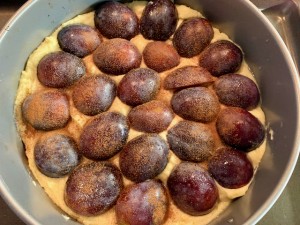
Place the batter in a pan, top with plum and sprinkle with lemon juice, sugar and cinnamon.

Plum torte
Ingredients:
¾ to 1 cup (185 to 250 ml) sugar
½ cup (125 ml) unsalted butter, softened
1 cup (250 ml) unbleached flour, sifted
1 teaspoon (5 ml) baking powder
Pinch of salt (optional)
2 eggs
24 halves pitted purple plums
Sugar, lemon juice and cinnamon, for topping
Preparation:
Heat oven to 350 degrees F (177 degrees C).
Cream the sugar and butter in a bowl. Add the flour, baking powder, salt and eggs and beat well.
Spoon the batter into a springform pan of 8, 9 or 10 inches (20, 22 or 25 cm). Place the plum halves skin side up on top of the batter. Sprinkle lightly with sugar and lemon juice, depending on the sweetness of the fruit. Sprinkle with about 1 teaspoon (5 ml) of cinnamon, depending on how much you like cinnamon.
Bake 1 hour, approximately. Remove and cool; refrigerate or freeze if desired. Or cool to lukewarm and serve plain or with whipped cream. Serves 8. (To serve a torte that was frozen, defrost and reheat it briefly at 300 degrees F/149 degrees C.)
From the New York Times
Sun 19 Jul 2020
Posted by Recipe Sleuth under New Finds
No Comments
This quick fish dish from the New York Times is tasty and uses your garden-fresh scallions, cucumber and herbs. Roast the fish for a few minutes and then add julienned scallions. While the fish cooks, make a quick sauce of scallion, yogurt, cucumber, herbs, lemon juice, garlic and oil. Serve the fish with the charred scallions and sauce. You can use halibut, cod or any firm white fish in this recipe.
Avoiding Additives and Preservatives
I use tamari instead of soy sauce, because it uses alcohol as a preservative instead of sodium benzoate. Astro Original Balkan-style yogurt and Cock brand fish sauce contain no artificial ingredients. Use only freshly squeezed lemon juice, as the concentrates are bitter and contain sodium benzoate. Check the red pepper flakes to make sure they don’t contain colour or anti-caking agents.

Make the cucumber yogurt sauce
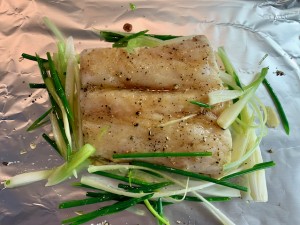
Arrange scallions around fish

Serve fish with charred scallions and sauce
Ingredients:
1 bunch scallions, green and white parts separated
3 tablespoons (45 ml) extra-virgin olive oil, plus more for drizzling
Fine sea salt and freshly ground black pepper
4 (6- to 8-ounce/170- 226-g) boneless, skinless halibut fillets
1 ½ teaspoons (7.5 ml) soy sauce
1 teaspoon (5 ml) fish sauce
⅔ cup (165 ml) plain Greek yogurt
⅔ cup (165 ml) finely chopped cucumber
1 tablespoon (15 ml) minced fresh dill or mint
2 teaspoons (10 ml) fresh lemon juice, plus more for serving
1 garlic clove, finely grated or mashed to a paste
Red-pepper flakes
Flaky sea salt, for serving (optional)
Preparation:
Heat oven to 450 degrees F (232 C). Mince enough of the scallion greens to equal 2 tablespoons (30 ml) and reserve. Halve remaining scallion whites and greens lengthwise to make ribbons. Place scallion ribbons in a bowl and toss with 1 tablespoon (15 ml) oil and a pinch of salt; set aside.
Season fish with salt and pepper, and place on a rimmed baking sheet. Drizzle fish with a little oil, soy sauce and fish sauce. Transfer to the oven and roast, 2 minutes. Add scallion ribbons to the baking sheet, spreading them out in one layer around the fish, and roast until the fish is opaque in the center and golden at the edges, and scallions are browned in spots, 6 to 10 minutes.
While fish roasts, make the sauce: In a small bowl, mix together remaining 2 tablespoons (30 ml) olive oil with 1 tablespoon (15 ml) minced scallion greens, the yogurt, cucumber, dill, lemon juice, garlic and salt and pepper to taste.
To serve, arrange fish and scallions on serving plates and squeeze lemon over the top. Dollop yogurt sauce over the fish and garnish with remaining scallion greens, red-pepper flakes, more black pepper, and sea salt, if you like. Serves 4.
From the New York Times
Sun 29 Mar 2020
Posted by Recipe Sleuth under New Finds
No Comments
This recipe from the New York Times uses canned tomatoes, canned black beans, tortillas, cheese, onions, peppers, garlic and spices — items most of us have in the pantry, fridge and freezer these days. Cooks the onions, pepper and garlic and then add cumin. Transfer half the mixture to a blender or food processor, add tomatoes, chili powder and hot sauce (if using) and blend. Add black beans and cheese to the vegetables in the pan. Cover the bottom of a baking dish with sauce. Assemble the enchiladas and place them in a dish, top with sauce and more cheese. Bake and serve with your favourite garnish.
Avoiding Additives and Preservatives
Make sure the spices don’t contain colour and anti-caking agents. Unico or Blue Menu tomatoes are additive-free, as are Blue Menu black beans. Original flavour Tabasco is additive-free. Check the cheese to make sure it doesn’t contain colour and look for tortillas without preservatives, such as PC Original flour tortillas. No Name sour cream is additive-free.
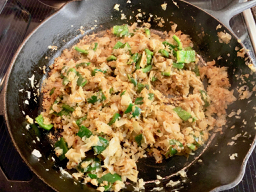
Cook onion, pepper and garlic
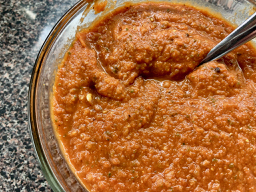
Blend half the vegetable mixture with tomatoes
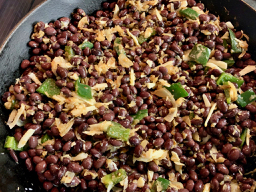
Add black beans and half of cheese to remaining vegetables
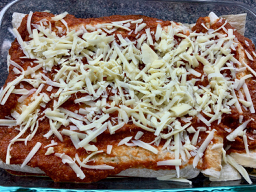
Assemble enchiladas and top with remaining cheese and sauce
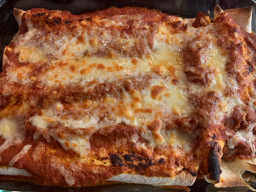
Bake until cheese has melted
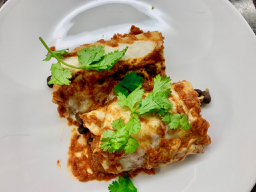
Vegetarian bean and cheese enchiladas
Ingredients:
2 tablespoons (30 ml) olive oil
2 medium yellow onions, finely chopped
1 red bell pepper or poblano chile, stemmed, seeded and cut into ¼ -inch (0.64-cm) pieces
4 garlic cloves, peeled and thinly sliced
Kosher salt and black pepper
1 ½ teaspoons (7.5 ml) ground cumin
1 (15-ounce/443 ml) can fire-roasted tomatoes, preferably crushed
2 teaspoons (10 ml) chili powder
½ teaspoon (5 ml) hot sauce or 1 chipotle chile in adobo, chopped (optional)
¼ cup (60 ml) sour cream, plus more for serving (optional)
2 (15-ounce/443 ml) cans black beans, rinsed
5 ounces (142 g) mild Cheddar or Monterey Jack cheese, grated (about 1 ¼ cups/310 ml)
10 to 12 (6-inch/15-cm) soft corn or flour tortillas
Fresh cilantro leaves and stems, for serving
Preparation:
Heat the oven to 425 degrees F (218 C). In a large skillet, heat the oil over medium-high. Add the onions, bell pepper and garlic; season with salt and pepper. Cook, stirring occasionally, until softened and charred in spots, 6 to 8 minutes. Stir in the cumin and cook until fragrant, about 1 minute. Remove from heat.
Transfer half the vegetable mixture to a blender; add the tomatoes, chili powder and hot sauce. Blend until very smooth. Season to taste with salt and pepper. (If your blender isn’t particularly strong and the sauce looks more like a chunky purée, add ¼ cup/60 ml sour cream and blend again until smooth.)
Add the black beans and ½ cup (125 ml) cheese to the remaining vegetables in the skillet and stir to combine. Some canned beans are already salted, so taste and adjust seasonings as needed.
Spread out the tortillas directly on the oven rack and heat until warmed and pliable, 1 to 2 minutes, then wrap in a kitchen towel to keep warm. Pour half the enchilada sauce (about 1 ½ cups/375 ml) into a medium casserole dish or a 9-by-13-inch (23-by-33 cm)baking pan and spread it to cover the bottom of the dish.
Line up the filling, tortillas and baking dish in a row. Place a little more than ¼ cup (60 ml) of the bean mixture in the center of one tortilla. Roll up the tortilla and place in the casserole dish, seam-side down. Repeat with the remaining tortillas.
Pour the remaining sauce over the enchiladas, then sprinkle with the remaining ¾ cup (180 ml) cheese. Bake until the cheese has melted, about 10 minutes. Top with sour cream and cilantro and serve immediately. The sauce and the black bean mixture, minus the cheese, can be made, covered in an airtight container and refrigerated up to 5 days in advance. Serves 4.
From the New York Times
Sun 17 Nov 2019
Posted by Recipe Sleuth under New Finds
No Comments
Another great sheet pan dinner, this one from the New York Times. Coat chicken pieces in oil, vinegar, garlic, paprika and oregano. Arrange on a baking sheet and add cherry tomatoes and peppers. Drizzle with oil, sprinkle with Parmesan and bake for about a half hour.
Avoiding Additives and Preservatives
Check the spices to make sure they don’t contain colour or anti-caking agents. Genuine Parmesan cheese contains no additives or preservatives.
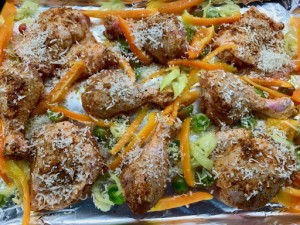
Arrange vegetables around the chicken and bake for about 30 minutes
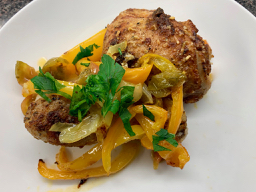
Sheet pan paprika chicken with tomatoes and peppers
Ingredients:
3 pounds (1.4 kg) bone-in, skin-on chicken parts (breasts, drumsticks, thighs or a mix)
Kosher salt
2 tablespoons (30 ml) extra-virgin olive oil, plus more for drizzling
1 ½ tablespoons (22.5 ml) apple cider vinegar, plus more for serving
2 garlic cloves, finely grated
1 tablespoon (15 ml) sweet paprika
1 teaspoon (5 ml) Espelette pepper or smoked hot paprika (pimentón)
1 teaspoon (5 mml) dried oregano
1 pint cherry (500 ml) tomatoes (preferably different colors), halved
1 poblano chile or 1 small green bell pepper, thinly sliced
1 cup (250 ml) thinly sliced sweet bell peppers (red, yellow or orange)
⅓ cup (85 ml) grated Parmesan
¼ cup (60 ml) chopped fresh parsley, for serving
Freshly ground black pepper
Preparation:
Heat oven to 425 degrees F (218 C). Season chicken all over with salt, and place it on a rimmed baking sheet.
In a small bowl, stir together olive oil, vinegar, garlic, paprika, Espelette and oregano. Pour over chicken, tossing to coat.
Add tomatoes, poblano and sweet peppers to baking sheet, spread vegetables around the chicken. Season vegetables lightly with salt and drizzle with a little more olive oil. Sprinkle Parmesan all over chicken and vegetables.
Roast until chicken is golden, crisp and cooked through, 25 to 35 minutes. Stir the vegetables halfway through cooking but don’t disturb the chicken. If white meat is done before dark meat, remove it as it finishes cooking.
Transfer chicken to plates. Stir vegetables around in pan, scraping up all the delicious browned bits from the bottom and sides of pan, and stir in the parsley and black pepper to taste. Taste and add salt if needed, and a drizzle of vinegar if you like. Spoon vegetables over the chicken to serve. Serves 4.
From the New York Times
Sun 29 Sep 2019
Posted by Recipe Sleuth under New Finds
No Comments
This dish from the New York Times is a great way to use up the last of the season’s tomatoes. Clean and debeard mussels (discard any that are broken or remain open), and cook the pasta. Meanwhile, create a delicious topping of capers, garlic and breadcrumbs. Cook tomatoes with garlic and hot pepper flakes and set aside. Cook the mussels in wine and oregano and remove them from their shells (discard any mussels that remain closed after cooking). Reduce the liquid and then return the mussels and tomatoes to the pan. Add butter, toss with herbs and serve topped with the breadcrumb mixture.
Avoiding Additives and Preservatives
Unico and Savor capers are additive-free. Use a butter without colour and freshly squeezed lemon juice. I used PC Black Label panko bread crumbs, which are additive-free and a white wine from Frogpond Farm with a sulfite level below 10 parts per million.
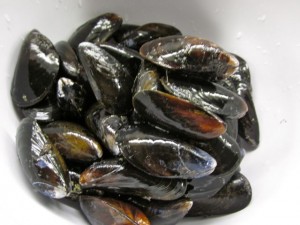
Rinse and debeard the mussels
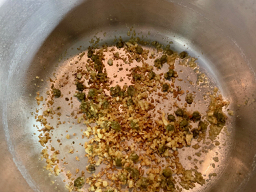
Make the breadcrumb and fried caper topping
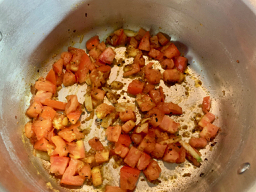
Cook tomatoes and garlic
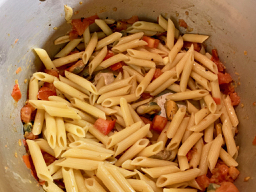
Add cooked pasta and shelled mussels
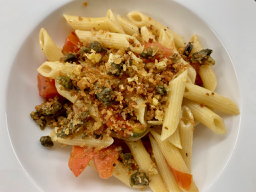
Top with breadcrumb-caper mixture and serve
Ingredients:
Salt, as needed
8 ounces (226 g) calamarata, rigatoni or other short pasta
4 tablespoons (60 ml) extra-virgin olive oil
2 tablespoons (30 ml) drained capers, patted dry
3 garlic cloves, 1 minced, 2 thinly sliced
⅓ cup (85 ml) panko bread crumbs
Large pinch of red pepper flakes
2 cups (500 ml) diced ripe, fresh tomatoes (2 medium tomatoes)
Freshly ground black pepper, as needed
Fresh lemon juice, to taste
½ cup (125 ml) dry white wine
3 large sprigs fresh oregano or marjoram
2 pounds (900 g) mussels, rinsed and debearded
1 tablespoon (15 ml) unsalted butter, at room temperature, cut into small pieces
¼ cup (60 ml) torn fresh basil or mint
Preparation:
Bring a medium pot of heavily salted water to a boil. Add pasta and cook according to package directions until 2 minutes shy of al dente. Drain.
As pasta cooks, prepare the bread crumbs: In a large pot, heat 3 tablespoons (45 ml) oil over medium heat. Add capers and minced garlic, and let sizzle for 30 seconds. Add bread crumbs, and fry until both crumbs and capers are golden brown, about 2 minutes. Scrape the crumbs and capers onto a plate, and season to taste with salt.
Add remaining tablespoon (15 ml) oil to pot and let it get hot. Add sliced garlic and red-pepper flakes, and let sizzle until garlic is golden at the edges, 1 to 2 minutes. Stir in tomatoes and a pinch of salt and pepper. Cook until tomatoes have softened and start to lose their shape, about 6 minutes. Use a slotted spoon to transfer tomato solids to a small bowl, add lemon juice to taste, and set aside.
Add wine and oregano to the pot and bring to a simmer. Add mussels, cover and cook over medium heat, shaking the pot occasionally, until mussels have opened and are cooked through, about 4 to 7 minutes. Transfer mussels with a slotted spoon to a large bowl, and let cool slightly. Discard any unopened mussels.
Simmer the mussels liquid until reduced to a glaze, about 5 minutes. Discard oregano sprigs.
When mussels are still hot (but not too hot to handle), pull meat from shells and add to the pot with reduced mussel broth (discard shells). Add pasta, tomatoes and butter, and toss well. Taste and add more lemon juice and salt if needed.
Transfer mixture to a shallow serving bowl and toss with herbs. Top with bread crumb-caper mixture and serve. Serves 4.
From the New York Times
Sun 1 Sep 2019
Posted by Recipe Sleuth under New Finds
No Comments
This recipe for the New York Times is a Korean dish also known as cheese buldak. It sounds a little strange to melt cheese over chicken, but it is delicious and the version made by Internet star Emily Kim (aka Maangchi) has had seven million views on YouTube! I used regular hot pepper flakes and Sriracha instead of the Korean hot pepper flakes and red-pepper paste. The rice cakes are optional.
Avoiding Additives and Preservatives
Check the red-pepper flakes and red-pepper paste for additives and colour. I used Simply Organic sriracha as a substitute for the gochujang and tamari instead of soy sauce. No-name pizza mozzarella is an additive-free low-moisture cheese.
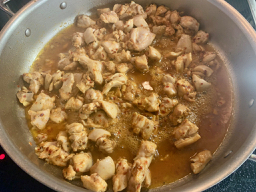
Stir fry the chicken
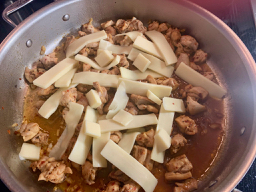
Place the sliced cheese on top
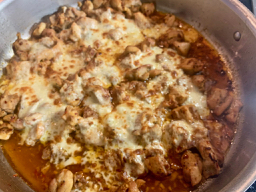
Broil until melted and beginning to brown
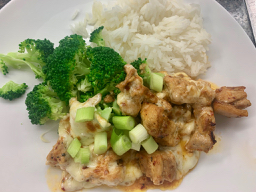
Fire chicken
Ingredients:
¼ cup (60 ml) gochugaru (Korean red-pepper flakes)
2 tablespoons (30 ml) gochujang (Korean red-pepper paste)
3 tablespoons (45 ml) light brown sugar
3 cloves garlic, peeled and minced (about 2 tablespoons/30 ml)
1 (1-inch/2.54-cm) piece ginger, peeled and minced (about 1 tablespoon)
1 tablespoon (15 ml) soy sauce
½ teaspoon (2.5 ml) freshly ground black pepper
1 pound (454 g) boneless, skinless chicken thighs, cut into ¾-inch cubes
2 tablespoons (30 ml) neutral oil, such as canola or peanut
4 ounces (113 g) sliced Korean rice cakes (optional)
6 to 8 ounces (170 to 226 g) low-moisture mozzarella, thinly sliced
2 scallions, sliced, for garnish
Preparation:
Combine the gochugaru, gochujang, brown sugar, garlic, ginger, soy sauce and black pepper in a medium bowl and mix well. Add the chicken and stir until it is well coated.
If you’re using the rice cakes, swirl the oil into a large, oven-safe skillet set over medium-high heat and wait for it to shimmer. Add the rice cakes and cook, turning the cakes often, until they are a little crisp, 3 to 4 minutes. Transfer the rice cakes to a small bowl and set aside. If you’re not using rice cakes, simply swirl the oil into the pan and move along to the next step.
Add the chicken mixture to the pan along with ¼ cup (60 ml) water. Cover and cook over medium-high heat, stirring occasionally, until the chicken is cooked through, 8 to 10 minutes, stirring in the rice cakes halfway through, if using. Meanwhile, heat the broiler in your oven.
Remove the chicken from the heat. Cover the pan with the sliced mozzarella, then slide the pan under the broiler. Cook until the cheese has melted and browned in spots, about 2 minutes. Remove from the oven, and sprinkle with scallions. Serve immediately, with rice. Serves 4.
From the New York Times
Sun 10 Mar 2019
Posted by Recipe Sleuth under New Finds
No Comments
This recipe from the New York Times is a great comfort-food meal for these cold, end-of-winter days. Fry some onions until soft and set half aside. Add spices and tomatoes and cook until slightly thickened. Meanwhile, cook some rotini or small pasta shells. Add the cooked pasta to the sauce with some parsley, top with the reserved onions and cheeses and bake until the dish is bubbling and the cheese has browned.
Avoiding Additives and Preservatives
Check the dried spices to make sure they don’t contain colour or anti-caking agents. Look for cheddar that does not contain colour. Genuine Parmesan cheese is all-natural. If you choose to use hot sauce, try original Tabasco or Simply Natural Organic sriracha.
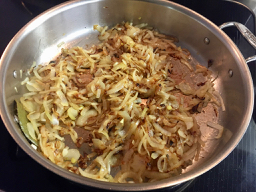
Cook onions until brown and tender
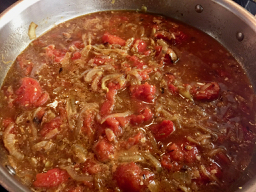
Simmer tomato sauce
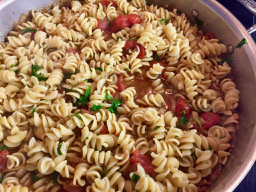
Add cooked pasta to sauce
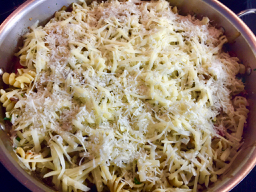
Place reserved onions and cheese on top of pasta and sauce
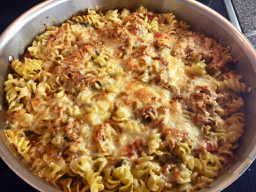
Baked skillet pasta with cheddar and fried onions
Ingredients:
6 tablespoons (90 ml) extra-virgin olive oil
3 large onions, thinly sliced
1 large bay leaf
1 ½ teaspoons (7.5 ml) ground coriander
1 teaspoon (5 ml) ground cumin
Pinch of cayenne, plus more to taste
1 ¼ (6.25 ml) teaspoons fine sea salt, plus more as needed
3 fat garlic cloves, minced
1 teaspoon (5 ml) cumin seeds
1 teaspoon (5 ml) black pepper
⅛ teaspoon (0.6 ml) ground allspice
1 (15-ounce/443 ml) can whole peeled plum tomatoes
1 pound (454 g) small pasta, such as rotini or shells
¾ cup (180 ml) chopped parsley or cilantro (or use a combination of cilantro and parsley), plus more for serving
8 ounces (227 g) shredded Cheddar
½ cup (125 ml) grated Parmesan
Hot sauce, for serving (optional
Preparation:
Heat ¼ cup (60 ml) oil in a 12-inch (30 cm) skillet over high heat. Add onions and bay leaf, and cook, stirring frequently, until softened and browned in spots, 12 to 20 minutes. (Reduce heat if the pan starts to scorch.) Lower heat to medium, and stir in coriander, ground cumin, cayenne and ¼ teaspoon (1.25 ml) salt; cook 1 more minute. Transfer half the onions to a bowl and reserve (leave the bay leaf in the skillet).
Add garlic, cumin seeds, pepper and allspice to the skillet, and stir. Cook until fragrant, about 1 minute. Pour in the juice from the canned tomatoes. Use your hands or kitchen scissors to squish or cut the tomatoes into pieces and add to pan. Fill the empty tomato can with water, and pour into the skillet. Add remaining 2 tablespoons (30 ml) oil and remaining 1 teaspoon (5 ml) salt, and bring mixture to a simmer. Simmer until thickened, about 20 minutes. Taste, and add more salt and cayenne if you like. Remove bay leaf.
As mixture cooks, heat oven to 400 degrees F (204 C) and bring a large pot of salted water to a boil. Cook pasta until just about 2 minutes shy of al dente. Reserve 1 cup (250 ml) pasta water, and drain pasta.
Stir pasta, reserved pasta water, and parsley into skillet with tomato sauce. Top with reserved browned onions, Cheddar and Parmesan. Transfer to oven and bake until golden and bubbly, 20 to 25 minutes. If you like, you can run the pan under the broil to brown the top, or leave it as is. Let cool slightly, top with more parsley, if desired, and serve with hot sauce, if you like. Serves 4-6.
From the New York Times
Sun 30 Sep 2018
Posted by Recipe Sleuth under New Finds
No Comments
In this recipe from the New York Times, farro (a type of wheat grain) is cooked on top of the stove then topped with salmon fillets. While the salmon steams, toss cucumbers, radicchio and dill with a lemony dressing. The farro turns out savour and chewy, the salmon is moist and the salad adds colour and crunch.
Avoiding Additives and Preservatives
All ingredients in this recipe are additive-free.
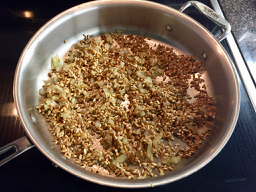
Cook onion and farro until grain is toasty
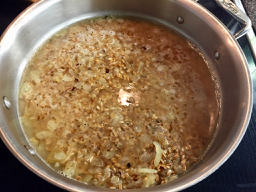
Add water and simmer
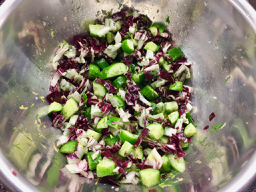
Meanwhile, make salad
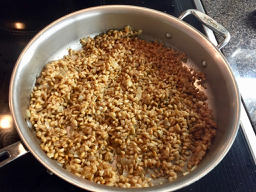
Farro is done when most of the water is absorbed and the grain is al dente
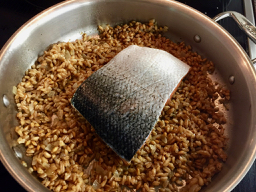
Place salmon fillet on top of farro, cover and steam
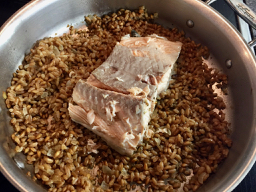
Remove skin from salmon before serving
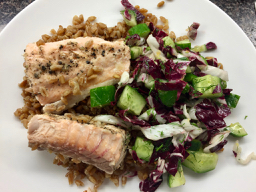
Farro with salmon, cucumber, radicchio and dill
Ingredients:
5 tablespoons (75 ml) extra-virgin olive oil, plus more as needed
1 onion, finely chopped (1 cup/250 ml)
Kosher salt and black pepper
2 cups (500 ml) farro (12 ounces/340 g), rinsed and drained
1 lemon
3 mini (or Persian) seedless cucumbers (7 ounces/198 g)
1 small head radicchio (5 ounces/141 g)
⅓ cup (75 ml) packed finely chopped dill
4 boneless salmon fillets (4 ounces/113g each, and about 1-inch/2.5 cm thick)
Preparation:
Heat 3 tablespoons (45 ml) of the oil in a large straight-sided skillet with a lid over medium heat. Add onion, sprinkle with salt and pepper, and cook, stirring often, until starting to turn clear, about 3 minutes. Add farro, sprinkle with salt, and cook, stirring, until the pan is dry and the farro smells toasty, about 2 minutes. Stir in 2 ½ cups (725 ml) water. Bring to a boil, then cover skillet, reduce the heat to medium-low, and simmer for 20 minutes.
Meanwhile, zest the lemon into a large bowl, then squeeze in its juice. Cut the cucumbers in quarters lengthwise, then slice into ½ -inch (1.25 cm) slices crosswise (you should have 2 cups/500 ml); add to the bowl. Quarter and core the radicchio, then thinly slice into ¼ -inch (0.67 cm) strips (you should have 3 cups/750 ml); add to the bowl. Add dill, remaining 2 tablespoons (30 ml) oil and a pinch each of salt and pepper to the bowl, and toss until evenly coated.
When the farro is done, season the salmon with salt and pepper. Uncover the farro. Most of the water should be absorbed and the grains should be al dente. Set the salmon on top of the farro in a single layer, skin side up if applicable. Cover and steam to desired doneness, 6 to 7 minutes for medium-rare. Remove from the heat. If your salmon has skin, grip a corner with a paper towel and peel off and discard; repeat with the remaining fillets. The skin should come off easily in a single piece.
Divide the farro and salmon among bowls, flaking the salmon into pieces if you like, and top with the cucumber salad. Drizzle with olive oil and season with salt and pepper to taste. Serves 4.
From the New York Times
Sun 19 Aug 2018
Posted by Recipe Sleuth under New Finds
No Comments
This delicious recipe from the New York Times takes advantage of in-season corn and tomatoes. Sear the shrimp and cook the bacon until it’s crisp (I actually cooked the bacon first and then seared the shrimp in the bacon fat). Cook corn niblets and scallions and then add cold, cooked rice. Press the rice into the pan and let it cook until a brown crust forms. Top the crispy rice with the shrimp, tomatoes and bacon and serve.
Avoiding Additives and Preservatives
Look for frozen organic shrimp with only salt added (fresh shrimp is often treated with sulfites to remain white). Use bacon preserved with celery salt.
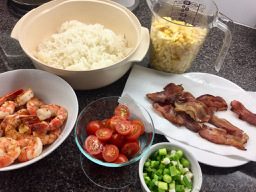
This recipe uses fresh corn and tomatoes
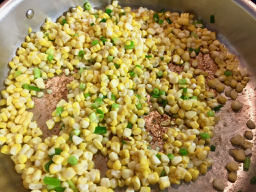
Cook corn and scallions after shrimp and bacon are cooked
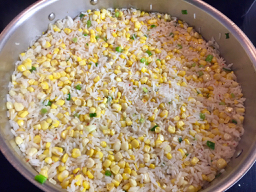
Add rice, pat into an even layer and cook until the bottom becomes crispy
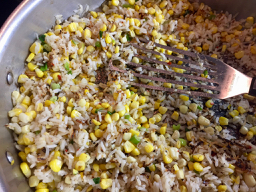
Scrape the crispy rice from the pan to serve
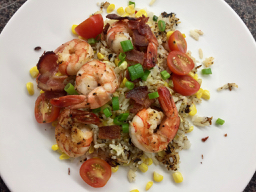
Crispy rice with shrimp, bacon and corn
Ingredients:
1 tablespoon (15 ml) vegetable oil
1 pound (454 g) peeled and deveined shrimp, patted very dry
Kosher salt and ground black pepper
4 strips bacon
3 ears corn
6 scallions
1 cup (250 ml) grape tomatoes, or 1 large chopped juicy tomato
4 cups (1 L) cooked rice
Preparation:
Heat oil in large cast-iron skillet or other heavy skillet over high heat. Season shrimp with salt and pepper. Add to the hot oil in a single layer and sear until browned, 1 to 2 minutes per side. Transfer to a plate.
Turn heat down to medium-low and add the bacon in a single layer. Cook, turning to evenly brown, until crisp, about 10 minutes.
While the bacon browns, shuck the corn and cut off the kernels. You should end up with about 3 ½ cups (875 ml). Thinly slice the scallions and set aside some greens for garnish. Cut the tomatoes in half. (If the bacon is done cooking before you’re finished slicing, remove the pan from the heat for a moment.)
Drain the bacon on paper towels, leaving as much liquid as possible in the skillet. Turn the heat up to medium-high and add the corn, scallions, and a pinch of salt to the skillet. Cook, stirring, until the scallions just wilt, about 1 minute.
Add the rice and stir until well-mixed and heated through, about 3 minutes. Press the rice evenly across the bottom and up the sides of the pan. Let cook, without stirring, as the rice and corn begin to crackle, until you smell a toasty scent and the rice browns, about 5 minutes. You can lift up a section of rice to peek and see if a golden-brown crust has developed.
Remove from the heat and divide the rice mixture among four bowls, scattering the tomatoes, shrimp and accumulated juices on top of each. (Alternatively, serve rice directly from the pan, with tomatoes and shrimp on top.) Season to taste with salt and pepper. Crumble the bacon all over and garnish with the reserved scallions. Serves 4.
From the New York Times
Sun 10 Jun 2018
Posted by Recipe Sleuth under New Finds
No Comments
This is an absolutely delicious dish from The New York Times cooking site. Blanch lemon quarters and make a citrus-honey-mustard marinade. Marinate the lemon, chicken, carrots, onions, dates and thyme, preferably overnight. Then dump the whole mixture onto a baking sheet and roast. Remove the chicken pieces are they are cooked, leaving the carrots for a few minutes longer to make sure they are cooked through. Delicious served with couscous.
Avoiding Additives and Preservatives
Use freshly squeezed orange juice and a mustard with no additives or preservatives; I use President’s Choice Old-Fashioned Dijon. Dates often contain sulfites, but you can find ones that are all-natural.

After marinating, arrange chicken and vegetables on a baking sheet and roast
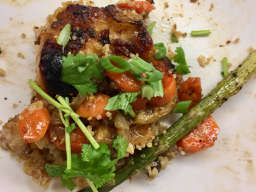
Sweet and spicy roast chicken
Ingredients:
1 lemon, plus 3 tablespoons (45 ml) freshly squeezed lemon juice
2 ½ teaspoons (12.5 ml) kosher salt, more for pot
3 tablespoons (45 ml) freshly squeezed orange juice
4 tablespoons (60 ml) olive oil
1 ½ tablespoons (22.5 ml) whole grain mustard
3 tablespoons (45 ml) honey
1 bay leaf
½ to 1 teaspoon (2.5 to 5 ml) crushed red pepper flakes, to taste
Black pepper, to taste
1 4-pound (1.8 kg) chicken, cut into 8 pieces
3 cups (750 ml) sliced carrots (¼-inch/0.6-cm thick)
1 onion, halved and thinly sliced
⅔ cup (165 ml) sliced dates
1 tablespoon (15 ml) fresh thyme leaves
¼ cup (60 ml) chopped cilantro or parsley, for garnish
2 scallions, thinly sliced, for garnish
¼ cup (60 ml) chopped toasted pistachio nuts, for garnish
Preparation:
Quarter the lemon lengthwise, removing any seeds. Thinly slice crosswise into small wedges and add to small pot of boiling, salted water. Blanch for 2 minutes and drain. Reserve slices.
In a saucepan, whisk together lemon juice, orange juice, oil, mustard, honey, salt, bay leaf, red pepper flakes and black pepper to taste. Bring to a boil and simmer for 5 minutes. Let cool.
Put chicken in a bowl and add honey mixture. Add carrots, onion, dates, thyme and blanched lemon slices. Turn mixture several times to coat. Let marinate for at least 30 minutes at room temperature, but preferably overnight in the refrigerator.
Heat oven to 425 degrees F (210 C). Transfer all ingredients, including marinade, to a sheet pan with a rim. Chicken should be skin side up. Roast until chicken is browned and cooked through, about 20 to 30 minutes for breasts and 30 to 40 for legs and wings (remove the pieces as they are done cooking). When the chicken is done, give the carrot mixture in the pan a stir; if the pan looks dry add 2 to 3 tablespoons water. Continue roasting the carrots until they are tender, about 7 to 12 minutes longer.
Spoon carrots over chicken and top with cilantro, scallions and pistachio nuts. Serves 4-6.
From the New York Times








































